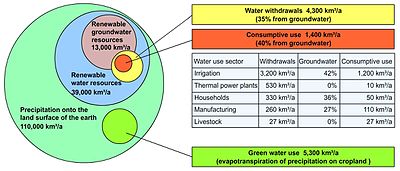
Back موارد مائية Arabic Su ehtiyatı Azerbaijani سو منبعلری AZB পানি সম্পদ Bengali/Bangla Recurs hídric Catalan Recurso hídrico Spanish Veeressursid Estonian Ur baliabideak Basque منابع آب Persian Vesivarat Finnish

Water resources are natural resources of water that are potentially useful for humans,[1] for example as a source of drinking water supply or irrigation water. 97% of the water on Earth is salt water and only three percent is fresh water; slightly over two-thirds of this is frozen in glaciers and polar ice caps.[2] The remaining unfrozen freshwater is found mainly as groundwater, with only a small fraction present above ground or in the air.[3] Natural sources of fresh water include surface water, under river flow, groundwater and frozen water. Artificial sources of fresh water can include treated wastewater (wastewater reuse) and desalinated seawater. Human uses of water resources include agricultural, industrial, household, recreational and environmental activities.
Water resources are under threat from water scarcity, water pollution, water conflict and climate change. Fresh water is a renewable resource, yet the world's supply of groundwater is steadily decreasing, with depletion occurring most prominently in Asia, South America and North America, although it is still unclear how much natural renewal balances this usage, and whether ecosystems are threatened.[4]
- ^ "water resource | Britannica". www.britannica.com. Retrieved 2022-05-17.
- ^ "Earth's water distribution". United States Geological Survey. Retrieved 2009-05-13.
- ^ "Scientific Facts on Water: State of the Resource". GreenFacts Website. Retrieved 2008-01-31.
- ^ Gleeson, Tom; Wada, Yoshihide; Bierkens, Marc F. P.; van Beek, Ludovicus P. H. (9 August 2012). "Water balance of global aquifers revealed by groundwater footprint". Nature. 488 (7410): 197–200. Bibcode:2012Natur.488..197G. doi:10.1038/nature11295. PMID 22874965. S2CID 4393813.